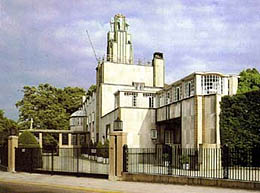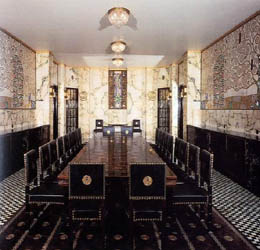
<title>Stoclet Palace</title> Stoclet Palace is an architectural icon, but the disputes about it continue
 |
Austrian architect Josef Hoffmann was born in 1870 in a small Moravian town of Brtnice near Jihlava. With a huge commission for the construction of his Brussels family residence, financier Adolphe Stoclet approached young Hoffmann in Vienna in 1904, rapidly accelerating his already promising career.
The construction of the magnificent villa with its garden took until 1911, and Stoclet nearly "bled financially" for it. The result of an unusually generous investor and a talented architect is a house designed down to the smallest details, in which Hoffmann conceived everything from furniture to garden modifications and even tableware, carpets, and bathroom tiles.
 |
When in 2002 the daughter-in-law of banker Stoclet, Anna, passed away, the house passed to her four daughters. While three of them would like to sell the inheritance and receive a proportional share of the proceeds, the fourth granddaughter Aude is fighting to keep the house preserved in its original form and to open it to the public with the help of a foundation. The legal battle has dragged on for years and is unlikely to conclude before 2009. Interested buyers, among them once American media magnate Ronald Lauder, will have to wait.
The marble-clad palace on Brussels' Tervuren Avenue is unmissable, and its uniqueness attracts even laypeople. However, only a tour of the interiors, which most people can only experience through browsing specialized publications, suggests that Stoclet allowed Hoffmann to create a kind of Gesamtkunstwerk.
The Stoclet family referred to the villa as the "magic house," and it’s hard to blame them. Among the forty rooms are a concert hall with a stage, generous bathrooms, game rooms, salons, fountains in the hallways, and kitchens that would make a modern hotel proud. The garden also features a gazebo and a tennis court, and in case of rain, a covered promenade is available.
The owners themselves tried to enhance the overall impression – when they invited politicians and artists to their home for parties, among them Igor Stravinsky, Claude Debussy, or Jean Cocteau, they supposedly dressed in outfits that matched the floral decorations. Even in his will, Adolphe Stoclet was stylish – when he died in 1949, he wished to be buried in a white silk pajamas with a handkerchief whose pattern was designed by Hoffmann himself.
Although the family's request to dress the banker in the coffin as a dandy was fulfilled, it will likely be more complicated to meet another demand of his. Stoclet wanted the house to remain as it was during his lifetime and to not suffer because of inheritance disputes. The billion-dollar estate, which Stoclet's palace, currently inhabited only by a caretaker, represents, of course, provokes disputes. Thus, the house's future will likely be determined by lawyers, not the last will of its first owner.
The English translation is powered by AI tool. Switch to Czech to view the original text source.
0 comments
add comment









